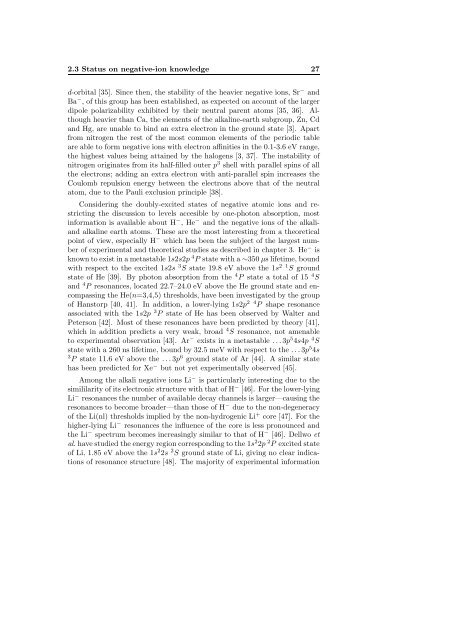VUV Spectroscopy of Atoms, Molecules and Surfaces
VUV Spectroscopy of Atoms, Molecules and Surfaces
VUV Spectroscopy of Atoms, Molecules and Surfaces
Create successful ePaper yourself
Turn your PDF publications into a flip-book with our unique Google optimized e-Paper software.
2.3 Status on negative-ion knowledge 27<br />
d-orbital [35]. Since then, the stability <strong>of</strong> the heavier negative ions, Sr− <strong>and</strong><br />
Ba− , <strong>of</strong> this group has been established, as expected on account <strong>of</strong> the larger<br />
dipole polarizability exhibited by their neutral parent atoms [35, 36]. Although<br />
heavier than Ca, the elements <strong>of</strong> the alkaline-earth subgroup, Zn, Cd<br />
<strong>and</strong> Hg, are unable to bind an extra electron in the ground state [3]. Apart<br />
from nitrogen the rest <strong>of</strong> the most common elements <strong>of</strong> the periodic table<br />
are able to form negative ions with electron affinities in the 0.1-3.6 eV range,<br />
the highest values being attained by the halogens [3, 37]. The instability <strong>of</strong><br />
nitrogen originates from its half-filled outer p3 shell with parallel spins <strong>of</strong> all<br />
the electrons; adding an extra electron with anti-parallel spin increases the<br />
Coulomb repulsion energy between the electrons above that <strong>of</strong> the neutral<br />
atom, due to the Pauli exclusion principle [38].<br />
Considering the doubly-excited states <strong>of</strong> negative atomic ions <strong>and</strong> restricting<br />
the discussion to levels accesible by one-photon absorption, most<br />
information is available about H− ,He−<strong>and</strong> the negative ions <strong>of</strong> the alkali<strong>and</strong><br />
alkaline earth atoms. These are the most interesting from a theoretical<br />
point <strong>of</strong> view, especially H− which has been the subject <strong>of</strong> the largest number<br />
<strong>of</strong> experimental <strong>and</strong> theoretical studies as described in chapter 3. He− is<br />
known to exist in a metastable 1s2s2p 4P state with a ∼350 µs lifetime, bound<br />
with respect to the excited 1s2s 3S state 19.8 eV above the 1s2 1S ground<br />
state <strong>of</strong> He [39]. By photon absorption from the 4P state a total <strong>of</strong> 15 4S <strong>and</strong> 4P resonances, located 22.7–24.0 eV above the He ground state <strong>and</strong> encompassing<br />
the He(n=3,4,5) thresholds, have been investigated by the group<br />
<strong>of</strong> Hanstorp [40, 41]. In addition, a lower-lying 1s2p2 4P shape resonance<br />
associated with the 1s2p 3P state <strong>of</strong> He has been observed by Walter <strong>and</strong><br />
Peterson [42]. Most <strong>of</strong> these resonances have been predicted by theory [41],<br />
which in addition predicts a very weak, broad 4S resonance, not amenable<br />
to experimental observation [43]. Ar− exists in a metastable ...3p54s4p 4S state with a 260 ns lifetime, bound by 32.5 meV with respect to the ...3p54s 3 6 P state 11.6 eV above the ...3p ground state <strong>of</strong> Ar [44]. A similar state<br />
has been predicted for Xe− but not yet experimentally observed [45].<br />
Among the alkali negative ions Li− is particularly interesting due to the<br />
simililarity <strong>of</strong> its electronic structure with that <strong>of</strong> H− [46]. For the lower-lying<br />
Li− resonances the number <strong>of</strong> available decay channels is larger—causing the<br />
resonances to become broader—than those <strong>of</strong> H− due to the non-degeneracy<br />
<strong>of</strong> the Li(nl) thresholds implied by the non-hydrogenic Li + core [47]. For the<br />
higher-lying Li− resonances the influence <strong>of</strong> the core is less pronounced <strong>and</strong><br />
the Li− spectrum becomes increasingly similar to that <strong>of</strong> H− [46]. Dellwo et<br />
al. have studied the energy region corresponding to the 1s22p 2P excited state<br />
<strong>of</strong> Li, 1.85 eV above the 1s22s 2S ground state <strong>of</strong> Li, giving no clear indications<br />
<strong>of</strong> resonance structure [48]. The majority <strong>of</strong> experimental information















